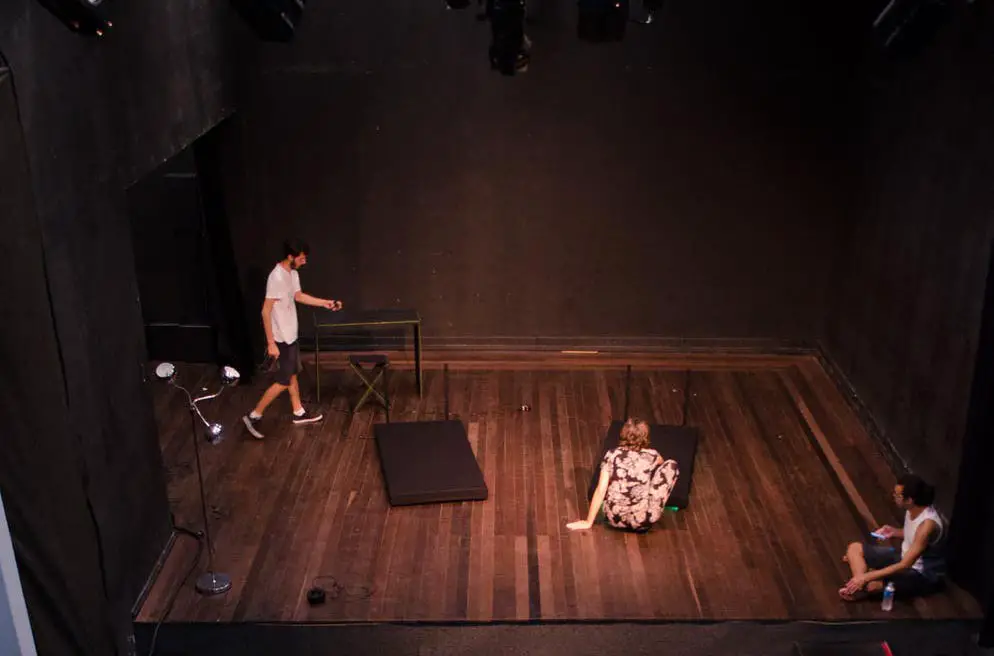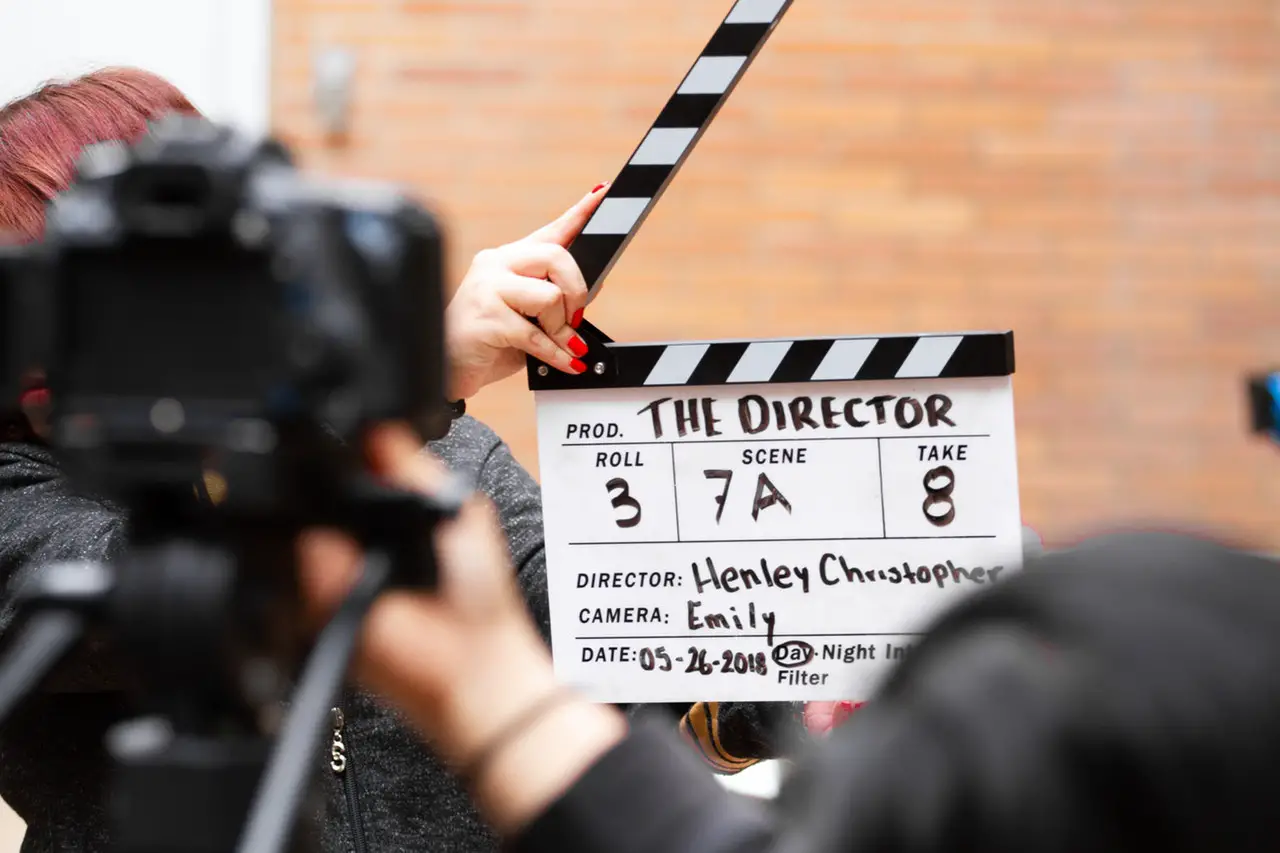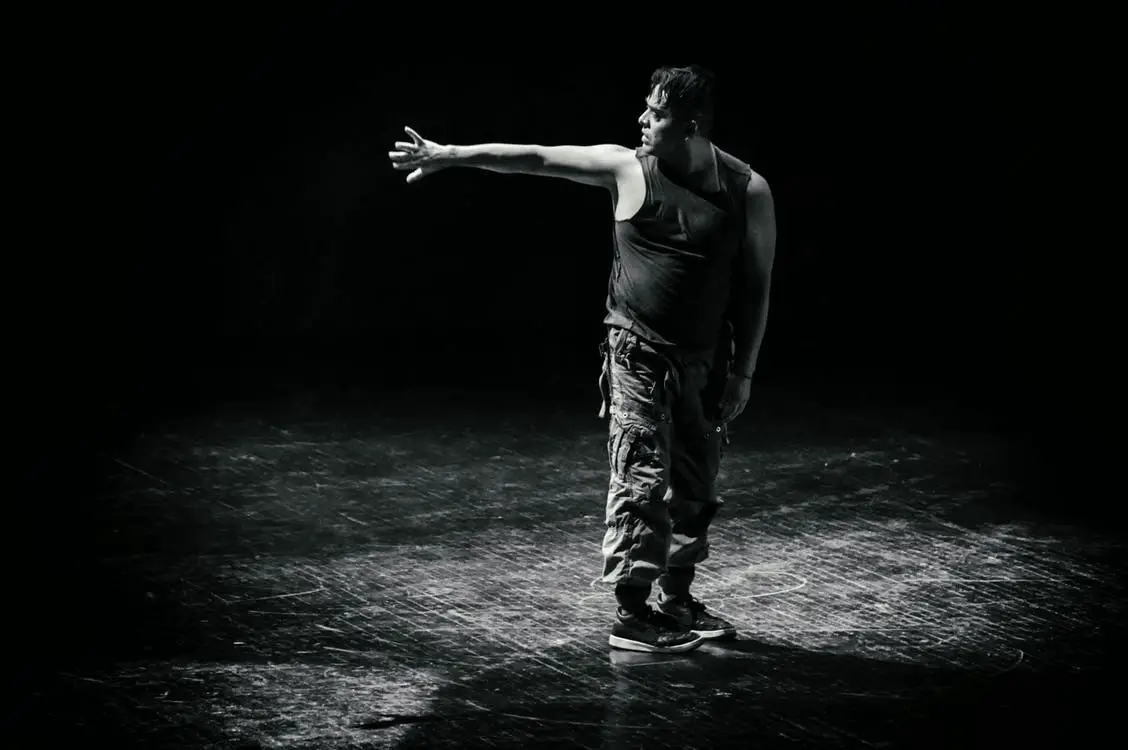![How To Deal With Sensory Overload [9 Tips For Overstimulation]](https://happyrubin.com/wp-content/uploads/2019/12/ik-ben-overprikkeld-150x150.jpg)
How do you improvise? 42 best improv theater tips!

What are the best improv theater tips? How can you improvise effortlessly in your acting game? In this article you will find 42 tips to create a very nice piece of improvisational theater. Read along!
Contents of this page:
Before we get to the tips: how does improv theater work?
In improv theater sports, small performances are improvised. The teams receive one piece of information as input for their performance. They ask that piece of information from the public. Examples of this are:
- And phrase you said today.
- A job
- A hobby with the letter J.
- A location (where you have recently been)
- A country
- An object
- A title for the scene
- A relationship between two people
The way in which the input of the audience is used is completely free. You can get creative with this.
In the improv television program ‘Whose Line Is It Anyway’, for example, the country’ Czech Republic ‘once emerged as the starting point from the audience, after which the improv-ers started a scene in a TV quiz:’ For the third question: the word Czech Republic has 13 letters. What is the third letter?’
Another example: you get a location, such as a theater. Then you don’t necessarily have to be in the theater, but you can also play a construction worker at a theater or just talk about a theater.
Actually, the improv theater sports teams often work with more than one piece of information: in addition to the input from the audience, they are also allowed to challenge other teams to throw a certain element into the performance. A third element is the choice of a ‘ theater sports game ‘, which ensures that your scene must comply with certain rules.
The improvised scenes can therefore be played in theater sports games, or formats. These can be compared with the parts you know from the television program ‘Whose Line Is It Anyway’.
Apart from these three elements (input from the audience, challenge and theater sports game), the entire performance is always completely improvised.
Improvisation theater tip 1: Go for the ‘Yes and!’ instead of the ‘No’

Suppose a character reaches out and tells you, “This is an apple.” Then it would be a “no” if you said, “That’s not an apple at all!” It would be a “yes” if you said, “Let’s poison this apple and give it to the queen!” You don’t have to see this tip as a literal ‘yes’ or ‘no’, as long as you make additions that help the story move forward.
“We must punish you now!”
‘Oh no! Not the chainsaw! ‘
So ask yourself: if this is true, what else is true?
“So, how nice it is here in Ikea!”
“How many meatballs do you want with that?”
And another way to put a ‘yes and’ down is to make the story that your fellow player is initiating extra clear to the audience, while you build on it. Let’s take the example where the location is a casino:
Croupier: “Everything is legal, boss!”
You: ‘I don’t doubt that! You are my favorite employee who I trust the most and who would never go illegal to do anything. ‘
Above all, make it bigger, more important and more dramatic. Let things escalate completely, because that too is a ‘yes, and …’
Of course you can also say no, as long as you help it forward in another way, for example with ‘but’: ‘No, but I do have {story forward solution}.’
Improvisation theater tip 2: Get concrete quickly: who, what, where?

Within the first 45 seconds, the audience should already know concretely where the scene takes place, who the characters are, including what kind of relationship the characters have (‘You are the son I never had, how nice, every day that bread. baking ‘) and what they are doing.
So you start by establishing the status quo, or ‘the daily routine when everything is still normal’. There is no problem yet. So you do not introduce the problem right at the beginning.
Let’s look at some tips on how to put this at the beginning of a scene ‘:
- Feel free to use a contrast-free turnout: you don’t have to think of everything yourself. You already create a very beautiful image by waiting to see what your fellow player is going to do , and then imitate your fellow player when you show up. You also take the same energy from the other. So the audience just sees two people doing the same thing!
- Put the true down through the area to paint and / or what to do in the area. For example, if you want to make it clear where the shop’s display case is, you can mimic that you go over it with a cloth. or you can add something from underneath. It is very nice for the audience if you make sure that they can hallucinate the different elements of a room. So sketch the environment. In a cafe you can make it clear where on the playing surface the bar, the sofa, the slot machine and the folder corner are.
- Put the who down by thinking of the following elements:
– Make something clear about the character ‘s interior : character traits.
– Make some clarity about the character ‘s appearance : “Wait a minute. Evan wipe all that greasy sauce off my hands and face. ”
– Make something clear about the living conditions / context of the character. These are for example: what the characters do in daily life, hobbies, profession and home situation.
– Get clear about the character ‘s history .
Improvisation theater tip 3: Use the ‘endow’ technique to give your fellow players the ‘who, what, where’ ‘
You can also tell your fellow players something about their ‘who’ (‘to endow’). “How did you get that big blood stain on your shirt?” In this case, we have given something external to the other. This can of course also be done on the inside, the living conditions and the history.
“Your face is flushed!”
“What! You are wearing a New York Yankees shirt!”
“You are overflowing with fear!”
“Are you going to sing very sexy – as it is really so typical for you?”
“What are those stains on your shirt?”
Improvisational theater tip 4: Give the characters a relationship
For example, to establish a relationship between two people, you can use the following two techniques:
- Determine what the characters think of each other. Simply find something from each other : super nice, super stupid, a cunt …
- Handy tool: think of ‘smelly, sexy, funny’. Who do you think is smelly, sexy or funny?
- Are you with three characters in a scene? Position yourself such that two people stand together and one character stands alone. Notice what this does to the relationships and how ‘ alliances ‘ are formed.
- Give someone a higher status and the other a lower status . See next tip.
Improvisational Theater Tip 5: Give someone a high and a low status

In a scene with several people, there are always relationships between the people. Give someone in the relationship a higher status and someone a lower status. This is especially visible in your physiology ( body language ) and voice .
- Low status: makes himself small, with arms close to the body, bent over, pleasing, responsive, quick talking …
- High status: moves slowly, talks loudly, recommends …
Improvisational Theater Tip 6: Use the ‘magic 3’: Action, Color, Emotion!
You can use any of these three elements at any point in the scene. Let’s see what these elements are:
- Action : You are not just going to talk in a scene, but you are looking for all kinds of ways to bring life to the brewery. For example, you storm into the door of the board, hit the table with your fist and scream.
Note: in action you do not use: ‘She thought then…’ - Color : You describe what you see in the scene. This could be the environment or something about the characters. “Wow Anneke, your face is flushed, the vein on your forehead could burst at any moment, and the table made an awful loud noise when you hit it just as hard!”
- Emotion : Share how your character feels. ‘I just felt the anger in my fist and at the same time the fear in my throat. Or no, I felt it all over my body, I was so panicked! ‘ You can also use emotion as an entrance to a story. Suddenly you can show an intense emotion during an everyday act. From there you can work towards a story. Stories often end with an emotion.
Improvisational theater tip 7: Let go of all expectations – Respond directly to what is happening ‘live’
An improvised scene can take a completely different turn at any time because one of the players takes a completely different direction. So let go of all your expectations from the scene. So insist: be in the moment. Dive into the moment and stay in it. It is wonderful if you can also include this in your daily life.
Usually, changing the direction of a scene happens in a serious way because one of the players decides to turn the plot around. There are also ‘silly’ examples, such as the ‘simple truth’. We will discuss this technique in the following tips.
Improvisation theater tip 8: Be enthusiastic and active and also immediately join the scene
Speed and enthusiasm are two extra strengths for an improvisational theater player. For example, use speed . Just throw yourself into a scene and find out what happens.
Another example is during the revolving door game format: turn very quickly to the next revolving door position so that you suddenly end up in the middle of the scene again. This means there is no time to think and there is more chance for improvisation.
Another example of speed: If you start a scene and want to ‘figure out’ what kind of action you are going to portray – or how you want to portray the location – just actively walk onto the stage. By the time you reach the end of the stage, you will have long since felt a sense of inspiration from the momentum that is within it .
Did you get an optician as a location? Just start walking and …
- You may notice that you walk a bit tough. Then it makes sense to play a cool character and ask: “Do you also have cool sunglasses here?”
- Or you may find yourself walking hesitantly. Then you can fall into an insecure assistant who has taken glasses from the warehouse.
- Or you seem to see something on the ground: “Hey, a lens.”
- Or you may find yourself walking a bit shaky. Then you can increase that again. “These glasses make me completely blind. I can’t see anything and I knock everything over!”
Speed is also reflected in the smaller things: are you the storyteller in a game, and one of the fellow players says hesitantly: “I want to join …” Then respond immediately by adding: “She said hesitantly.” Your direct response here fit nicely in the here and now. It could only have worked that exact second. If you started thinking for a moment, the moment was over.
Go directly into the story with enthusiasm . Think about how easy it becomes to come up with things if you do it with enthusiasm. For example, during a theater sports lesson, we played a game where we point out objects, and we name it with the name of the object that we have designated for that. Then we had to stop doing that, just give the object a random name. Coming up with this was much easier when we did it with an enthusiastic voice and attitude. It also became much easier when we started using our body more.
Improvisational theater tip 9: Action and speed take precedence over talk – Take action and make decisions

Continuously focus on: how can we minimize talking about things and maximize actual portrayal of things (action)? So regularly think about action, action, action and speed!
Is a scene about a princess and she says, “If only I had a man …” That could then be a sign for one of the fellow actors to walk onto the stage and say, “Here I am, the prince.” And if they then talk about their desire to have children, then it is perfectly possible to take action: ‘Lie down, I want a child.’ And that could be another sign for a third player to take the stage as a child. And if the children need to be fed, a fourth player could walk onto the stage: “I’m the butler.” In this way there has been no endless talk, but a lot of action, speed and dynamics.
So think constantly: how can we make the scene dynamic and prevent it from becoming just a talking scene? Suppose you received a knife from the public as an object. Then think about how you can get immediate action in the scene. This can be done, for example, by pretending that you got stuck somewhere. In this way dynamics and drama can be created in the scene.
If a scene is about how sad someone thinks it is that lions live in captivity, let there be action by actually freeing a lion from the cage and actually lifting the lion into a car (or magic missile).
In addition, use the entire stage. Do you notice that all the characters have been in a corner for a while now? Then also perform some actions at the other locations of the stage. This also immediately results in more movement. Use the space. So sometimes go to another place in space: move. This even provides extra inspiration.
Movement is good. Is a scene set in a museum and is it about a gigantic ball on display? Let the ball roll off the pedestal or turn it into a fantasy scene by letting the statue fly away. Suddenly there is action and drama.
You can also portray multiple locations, scenes or abstract things simultaneously via two or three layers on the stage to support what is discussed or done on the front layer.
Finally, a handy tool to get more action: feel free to make an ‘ edit ‘ if you notice that there is too much noise …
“I’m curious how the boxing match will go.” “3 weeks later during the boxing match …” There is then a new time and space and in a match something physical can happen.
“Let’s build our own church!” ‘3 weeks later when the building is finished …’
“Remember what we started this for 10 years ago?” ‘Flashback to 10 years earlier …’
“Then who could have eaten the apple pie?” “Flashback to an hour earlier.”
In short: play it out instead of talking about it!
Improvisational Theater Tip 10: Never negotiate in a scene – make the decision
A negotiation is not a representation. That does not belong to theater sports. If you ever find yourself in a situation where for one reason or another a negotiation has started between characters, make the negotiations very unreasonable and never agree. If necessary, use the tip: ‘action, color, emotion’ from a few paragraphs back to work on this.
Action is preferable to unnecessary idle time for too long. Do you notice that your fellow players spend just too long on a doubt or reflection situation? Feel free to make an ‘edit’: ‘5 minutes / 3 years later when Harry has decided to trust the Orc.’
Don’t think too long about a dilemma: CHOOSE!
Improvisation theater tip 11: There is unlimited budget for special fx – Stimulate your imagination with science fiction series

In improvisational theater you have an infinite budget for special effects. So it would be very valuable if you could actually make use of this infinite special effects budget in an inventive way during a scene.
Imaginative series such as Adventure Time, Stranger Things, Rick & Morty and Futurama are good examples of limitless fantasy. This way you can easily come up with tools that you improvise to overcome an obstacle.
I hired a Russian hacker to find your address!
Improvisational theater tip 12: Create drama (important goal + obstacles = drama)
How do you create drama? Use the following formula: a clear, important goal + (several) obstacles = drama . So show in a scene what the purpose of the characters is and what obstacles there are.
Thinking up an obstacle can be as simple as a tire that goes flat or an emerging conflict between two people. Often the obstacle arises almost automatically when the ‘who, what, where’ of a scene is clear. More about that later in another tip.
The obstacle can really be anything: be creative. For example, a dictator of the country has banned dancing, preventing the protagonist from fulfilling his dance dream.
Then you exaggerate the importance of the goal. For example, a patient comes to the doctor for help and says, “I’ve already tried everything, you are my last hope !!” So there must be a lot at stake. What was his greatest wish? What did he want so badly? What is his dream?
Let the situation escalate completely.
Always make it bigger, more emotional, more important and worse. ‘Will I get enough to eat later? Will I soon have to go into prostitution? ‘ “There is 10 million to be gained and 10 million to lose.”
The TV series South Park owes its 20-year success to its strong, interesting storylines. The makers of South Park call their variation on this principle: The But / Therefore Technique.
Simple example: the princess needs to be rescued … but there are dragons … so the hero has to undergo ninja training … but during the fight with the dragons the dragons turn out to be much stronger … so help comes from a previous character …
So avoid an and-after construction. If your story goes like this, you are screwed as a storyteller: Piet takes a ninja training, and then he meets dragons, and then he saves the princess …
So apply these simple formulas:
- Major goal + obstacles = drama
- But … + so … + but … + so … = drama
These are the most simple formulas, but if you want to expand them with more elements, you can! You can do this by adding more elements from ‘De Journey of the Hero’ . For example, you can add how the main character is different now that he has reached the goal. At the end of the scene, explicitly mention the goal again.
Is the story of something getting too powerful, like an AI? Then let it escalate completely. “We shouldn’t make the AI too intelligent or it will kill us …”
Improvisational theater tip 13: Work on an internal problem, which solves the external problem
An internal problem is the deeper problem between the characters. The external problem is the visible challenge in the scene. The characters solve their internal problem and therefore you can also solve the external problem together.
How do you get an internal problem? Use the following inputs for this:
- Generalizations: “You always say that!”
- Omissions: “You never say you love me!” ‘What you never say is …’
- Distortions: “What you really mean is that you think I’m ugly.”
If the generalization, omission or distortion (part of the NLP communication model) has been resolved (internal), then the characters can chase the cat away together (external)! If necessary, you can put the solution to the internal problem on top: “Indeed, he does too, that creates a bond!”
Improvisational theater tip 14: Use emotions, alliances and pregnant announcements as input for a different meaning, story or charge
As you could read in the previous tips, action is an important means of moving a story forward. You can also use more subtle ways. If there is not really a story in your scene yet and it is time for a plot twist , use the following input, for example:
- New emotions are a subtle way to send a story. Is everyone happy and does a character suddenly start crying? Then suddenly there is a story. Why is he / she crying? Who has ever wronged him / her?
- Throw in a pregnant announcement : “I have something to confess to you …”
- Symbolically form an alliance . If there are three characters in a scene, one character can suddenly stand next to another character, making it clear that they have formed an alliance against the now single character. Suddenly turn on someone. For example, if you play a scene where you rob a bank together, suddenly point your gun at the other.
Improvisational Theater Tip 15: Exaggerate – Put on something big

Does a scene seem to be heading in a certain direction? Make it bigger! Make things more theatrical / outspoken / exaggerated.
- For example, if there is a death scene: die across the table or die in an extremely theatrical way.
- For example, have you (become) the victim? Play that excessively, for example by crawling on the ground.
- Are you making tea? Then do it with beautiful, large, graceful gestures.
Improvisation theater tip 16: The ending can also be an anti-climax
You don’t have to work towards a ‘happy ending’. There are plenty of other options. Suppose an entire scene works towards convincing the protagonist not to poison his mother-in-law , the scene can end with an anti-climax by making him decide to reach for the cyanide after all.
A solution to the goal and the challenge can also be a symbolic solution. If the main character’s goal is to fly, the solution can also be symbolic: for example, a pill to ‘float’ instead of actually float.
Are you looking for an ending for your story, but you don’t really have a good idea yet? The simplest rescue routes you can use are letting an important character die or failing the mission completely in a jet-black ending.
Improvisation theater tip 17: Feel free to help each other!
Help each other: for example, is it not really clear why the goal is so important to one of your fellow players? Then just ask:
- Why do you think it’s so important?
- And then she explained why it was so important to her.
- So much depends on it, namely …
Improvisational theater tip 18: Make ‘edits’

You can just cut in your scene, just like you would if you were making a movie. For example, say:
- “Meanwhile at {location}.” A nice time to do that is immediately when you hear the location.
- You can also make an edit to the past or the future. For example to ‘earlier that morning’, where you emphasize the motif of a character: ‘It’s very important to me to sell that fish!’
- You can also break through the fourth wall to reveal the character’s motif or secret to the audience. Or more importantly, to convey the importance of the main character’s goal to the audience. “Actually, I’m cheating.” Or: ‘I had planned a surprise: soon a fanfare will arrive.’
- If your fellow player says: “I hope she doesn’t see that one box in my bedroom …” then it is always good to ‘edit’ directly to the action: “Meanwhile in Carlo’s bedroom …”
- When the game format is structured in such a way that the scenes are interrupted and then continue later, such as ‘The Revolving Door’, the resumption of a scene is an excellent opportunity to jump straight ahead in time.
Improvisational theater tip 19: Train yourself to make associations
Make associations and let things emerge without filtering yourself. Let everything arise in the moment. For example, improvisation theater lessons often involve an exercise in which you point to objects and say any other word. The less inhibition and the less you filter yourself, the better. Even if they are ‘bad’ ideas.
If you want more ideas to further dress up your scene, use Edward de Bono’s flower association technique. You can find this technique in the article about the creativity techniques of Edward de Bono.
You can also do an NLP New Code Game , where you always have to answer math problems, imitate someone and make associations at the same time! Making associations is then very easy!
Improvisational Theater Tip 20: Work with your physiology and voice
If you play a certain character, adopt a slightly different attitude and use a different voice. A very simple example: ‘Hello, I am the forester’ is not done with your normal voice, but with a deeper voice.
Improvisation theater tip 21: You color a scene with a character
A scene becomes much more interesting if you experience it as a character. How? This is mainly in your body and your voice. Just look at the video above by Hans Teeuwen, in which every inhabitant of the fairytale forest is a clear character. Turn on the English subtitles.
For example, use your body. The Burgundian has a round belly, the ‘mother goose’ has her buttocks back and is staggering a bit, the dirty man has his crotch forward, the busybody has his nose out, the king has his chest out …
Theater sports games also often use associations. For example, you have a theater sports game where you have to act out a scene in all kinds of different film genres. Then it can be useful to be aware of the elements of each film genre:
Western
- Stand wide, with two guns to your side.
- Adjectives for each name: Fast Freddy, Mad Dwaze Dolf …
- American words: “This is my town / saloon.”
Swedish krimi
- Everything is tough and difficult
- Much sighs
- Depressed
Hospital series
- Statusverschillen
- Handsome doctors
- Cheating on me
Horror
- Things that are locked
- Squeaky doors
- Suddenly the light goes out
- Suddenly you feel next to you and suddenly you feel a weapon somewhere
- Wolf in sheep’s clothing: a friendly woman who comes to help, but who is actually an evil genius
Pirate film
- A cross on a map
- Drink, rum
- Ducats, shadow
- A hook (Captain Hook)
- ‘Aye matey’
- Bluebeard
Action movie
- Pursuit
- Oneliners: ‘I’ll be back’
- Spies
- Stunts (rollover)
- Grenades being thrown
Romantic comedy
- Accidentally dropping papers
- Getting to know someone clumsy and shy
- Finish each other’s sentence
Film Noire
- A narrator
- It is always night
- Cigarettes are lit
- Everything is serious
- Everything is suspect
- “At that moment I knew exactly who was sitting next to me. I tried not to make eye contact.
” I have no idea who you are. “” I knew exactly who he was. I had closed that chapter years ago. “ - Narrators who contradict each other (parody): “He does not know that I am divorced with my wife.” “I know he is divorced with his wife.”
- The narrator who ‘endows’ the other co-player (s): “I was sure he would take that gun now.”
Costume drama
- The corset
- Status differences
- A separate room where the servants live
- “I’ll prepare everything for dinner”
- “I beg your pardon?”
- Baroness Victoria of Liechtenstein
You can also study associations based on types:
Nerd
- Keep pressing his glasses up on his nose
- Grunt like a pig
Emo
- Cynical
- Kicking against society
Campers and hooligans
- Car on the sidewalk
- Tracksuit
- Large dog
- Beer
- Assistance
More characters
- Lovingly soothing, peace-keeping mother
- Just someone of high or low status – expressed in body language
- Shy
- Chic
- Snobs
Improvisation theater tip 22: Tease yourself and your fellow players

Feel free to get your fellow players into trouble. That way you make it fun and challenging. For example, by having them do something ‘difficult’: ‘So, you are on time. Take off your clothes. ‘ The other person can make it difficult for you to ‘get you back’: ‘All other times you always helped me with that.’
Suppose a new scene starts with the object ‘Bicycle Pump’ as input from the audience. Then you can immediately piss off your fellow player by talking to him / her about an ‘interesting’ role.
“Are you the sexually suggestive bicycle pump?”
And as you know: in inspiration you always have to go with the flow. Your fellow player is therefore not allowed to say no.
“Yes, I am the sexually suggestive bicycle pump.”
“Can you pump up my ball for me?”
You can challenge or tease yourself and your fellow players by saying something in the middle of a scene, such as: “I have the following 3 important things to say …” Now you have to list three things.
You can also do something completely unexpected: you can, for example, choose to suddenly completely mirror the other character in terms of status. For example: the teacher who suddenly also talks like a student, but is still the teacher and gives advice.
Are you the man who touches people inappropriately?
Another way to confuse your fellow players is the ‘Simple Truth’. The simple truth is a classic technique where you interpret a representation or statement in the simplest way.
For example: a player is acting out getting a dirt out of his mouth because his food fell on the floor of the snack bar. Then a fellow actor can give the scene a completely different meaning with the simple truth: he interprets the depiction as eating spaghetti. ‘We do have spaghetti here at Snackbar De Vette Italiaan.’
Another example of the Simple Truth: a player is portraying them holding the pipes of bars because the audience had given the location ‘a prison’. To this a fellow player can say: “Nice that you are holding your brushes, but we really have to continue painting these prison walls.”
More examples of bullying your fellow players:
- Within theater sports there is a form of game where you have to play the voice of your fellow player. This is ideal to tease your fellow player because you can make him / her do all kinds of difficult things: “Look, I do it for you: you first make a handstand as you can see now, and then …”
- In the same game format, you can ‘misinterpret’ someone’s portrayal / mime with ‘the simple truth’: does your fellow player hold bars, which would clearly fit into the story? Then say something that doesn’t fit at all: “Look, I’m holding sticks.”
- If your fellow player waves because the bus is coming and the player really means that and because it would make sense, show something completely different: “Look, there is God. You see, prayer works! ‘
- “With this spell your curse has been broken and the price you pay is that from now on all your sentences are rhyming together.”
Improvisation theater tip 23: Be aware of ‘bites’

A bite is a small part of a scene that ends with a small climax. Be aware of the end of a bite. The end of bites are the moments when you can only make a transition to something else, walk away or start doing something else. This is also true in real life. Suppose you are a teacher and you are walking around to see how your students are working. You join a group to see how they are working, and after a certain insight or joke you walk away to the next group.
Improvisational theater tip 24: You can make mistakes – You don’t even need to know your primary school material, such as biology and topography
There are those things that every Dutch person has learned in primary school. The audience kind of expects you to know those things. You just need to know in which province a particular city is located, so that you can speak the corresponding accent.
However: don’t worry about that! If you actually have to speak Frisian, while you don’t know a Frisian accent, you can also speak like an illiterate or perfect Enlisgh. It doesn’t have to be logical and you don’t have to do anything.
- Do you get ‘Hogwarts’ from Harry Potter as a location, even though you have never read Harry Potter? Doesn’t matter, just start. Call all kinds of Star Wars references if necessary. It’s all allowed.
- Do you have to recite a ‘sonnet’ without knowing what a sonnet is? Maybe you think it’s some kind of serenade? Sing a serenade … and wink with a wink that you thought this was a sonnet.
All of that is much more fun, funnier and more challenging than confessing that you don’t know what it is. On the other hand … Nothing is too crazy, and sometimes the easiest solution is just the best: Do you have to play a Pool and you don’t know a Polish name? You can therefore safely break through the fourth wall in the middle of the scene and secretly ask the audience for a Polish name.
It doesn’t have to be perfect. In fact, it doesn’t even have to be right.
Improvisational theater tip 25: Remember where all objects in the room are physically located

You cannot walk through a door if the door was closed by the previous character. Pay attention to these details.
Improvisational theater tip 26: Offer yourself as a backdrop / background figure
If you are with many players, not everyone can play a prominent role. Therefore, sometimes play decor or play characters in the scene as background fill. You can also provide your active fellow players with sound effects or you can use your body to create special effects in other ways.
Support the playing players visually. For example, when an object is thrown at each other, you can portray that flying object with your hand.
If a building is being built by your fellow players, figure the building once it is finished.
If one of your fellow players is miming that he / she turns on an LP player, walk over to it and act as the LP player.
In the form of play in which an opera is played, the bench-siters also come in handy: sometimes sing sentences in the background or repeat the sentences that the main character sings: ‘What’s there? What has she got? ‘ And repeat a lot: ‘Diamond, diamond found found !!!!’
It would be great if you could combine sound effects with backing vocals. For example, if a scene is set in a barber shop, hum along like a clipper sound.
Do you play the decor or are you a background figure? Then add some ‘altitude’: if everyone is standing, it is interesting if you lie down correctly. Or look up the height by, for example, standing on a chair.
Improvisational theater tip 27: Also dare to play small, emotional scenes
Theater sports has the trap of only wanting to play exuberant, exaggerated scenes. Also remember to play something sad and restrained for once.
Improvisational theater tip 28: How can you evoke an emotion on stage?

- Change your breathing. For example, someone who is scared breathes quickly and shallow.
- Change your facial expression. For example, someone who is aroused would run his / her tongue over the lip.
- Add a voice: what does someone who is afraid sound like? What kind of sounds does such a person make? Someone who is angry may speak words restrained, with a tight mouth.
- Change your posture. What is the posture of someone who is afraid?
- Behavior: what does an evil person do? Maybe he pushes a chair that happens to be in front of him very hard to a fellow player. Maybe he’s pushing a fellow player.
- Add a motif / goal for yourself. Why is something bad? Like a break up? Or that your characters are getting old? He / she doesn’t want to end alone.
- Do if you have one emotion. You can read why and how this simple trick works here.
Here you will find more tips on how to evoke a feeling.
Improvisational theater tip 29: Color an emotion
You can ‘just’ play the emotion of happiness or horniness, but you can also play, for example, restrained anger, joy or horniness. In this way you can bring it more subtle – and thus with more color. For example, at restrained happiness you can chuckle, hold back your laugh or ‘fake’ that you are angry, while it is abundantly clear that the character is very happy. With restrained horniness, the funniest comments can arise: “I have a pain in my leg.” ‘I am a virgin.’
Improvisational theater tip 30: Work with multiple layers of emotions

Emotions come in layers. After anger comes sadness, then fear, and finally guilt and shame. Notice how the top layers, anger and sadness, are less interesting than fear, guilt and shame. So find out what happens when you take advantage of those last three emotions.
Improvisational theater tip 31: Work with two layers of consciousness: the actor and the character
This tip comes down to method acting. Step into the character’s skin and become a character (layer 1) , instead of just illustrating a character and the character’s actions (layer 2) . The actor illustrates. Not the character. Become the character.
How do you step into the character’s layer?
- Visualize a location where the scene takes place, literally in front of you.
- What does it do to you that other characters say certain things or move / act in a certain way?
- Not only are you illustrating that you are smoking a cigarette or putting on shoes, but in the meantime you are the character who thinks about the situation he / she is in.
- While illustrating, you can have a dialogue or the other players ‘endow’, as you learned in a few tips ago. That way you are not only busy with miming / illustrating (the actor does that), but you are also busy with something else on the second layer (the character does that).
So don’t illustrate. The actor illustrates. Not the character. He knows nothing about it. He is now doing something else. The actor wants to show that he plays emotions, the character is not aware of them, he / she is aware of the content (with a certain emotion) while he / she lights a cigarette.
Not everything needs to be clearly disguised and not everything needs to be named. Just show it.
What helps anyway is to continue an action while having a dialogue. Then you automatically no longer have your conscious attention just on illustrating the action.
Improvisation theater tip 32: Sitting is not mimicked, but walking is
When characters are seated, they are always in a physical chair. Walking (from one location to another) is best mimed. That means that you make the walking movement, but in the meantime just stay in place. This way you can imagine that greater distances are covered.
Improvisational theater tip 33: Take your time to let everything arise in the moment: your character, your text, everything …
Often you have to put energy and speed into your game, but at many times it is important to be ‘slow’ so that you actually come into contact with what is happening in the moment. Allow yourself time to discover the scene. If a scene is just starting and the ‘who, what, where’ has yet to become clear, repeat, for example, the sentence that the other says (a few times) and notice how that suddenly makes you fall into a character.
Improvisation theater tip 34: Use silence tolerance, because that creates beautiful things
Thanks to your ability to let silence fall, you can:
- Do much more with your facial expressions.
- Letting your emotions speak, instead of trying to solve everything safely with words.
- Give yourself and the other more room to think about coming up with a brilliant idea.
- Making emotions extra powerful, such as love.
- Silence also gives you the space to add subtext, step out of an emotion and transition into a new one.
Improvisation theater tip 35: Let each other finish
Small but important tip: be sensory sharp and aware of each other so that you let your fellow players finish the conversation.
Improvisational theater tip 36: Make (eye) contact, send your message completely to your fellow players and reach each other

You can send a few sentences onto the stage, a little bit into the air … or you can really communicate with each other – where your message and your feelings really arrive and are received. You do that as follows.
- If you send a message, get close to the other, make eye contact and really send the message to the other player. Also have empathy for the other player. “How does that feel then?”
- If you receive a message from a fellow player, let it really come in, process your reaction in silence and only then respond. See next tip about collecting.
Improvisation theater tip 37: ‘Taking it in!’ Collect!
What is meant by ‘taking it in’? That means that your character does not immediately react to what is happening or being said. You are going to be aware of what is happening in silence, for a long time. Only by showing emotions. Often in several phases. Often there is also surprise and denial, maybe followed by a lump in the throat … after which it ends in total panic.
At first you slowly realize what is happening. That happens in silence. It slowly descends into you … and only then do you escalate with your emotions, for example in panic! That is always a useful emotion!
Improvisational theater tip 38: Use what happens in the here and now – ‘Utilization’

Often something is just ready to use … Utilization is one of the most important principles of theater sports. Utilize everything! In other words, use everything that has happened or said before and let it come back , preferably in a way that you develop the story further or bring it to an end.
If you use utilization, you often don’t have to come up with something completely new yourself. Just think about what has been said before. You can even use things that were said in the preliminary conversation, while asking for suggestions from the audience, but were ultimately not chosen.
Synchronous is beautiful: two people doing the same thing. So do the same. Utilize what a fellow player is already doing, instead of coming up with something extra yourself. If someone is tapping his / her keyboard in an angry and furious way, do the same next to each other. This is a nice picture.
Another example of utilization is “pointing to / repeating the truth.” This is, for example, literally describing what was previously described, or literally repeating what someone else has said, with the same words. This seems far too ‘simplistic’ but you have to realize that you have to tell a story that is as clear and simple as possible. And literal utilization helps with that.
For example, if the narrator tells you that the hero is going to a secret entrance behind the pyramid, you also say that: “Aha, I am now at the secret entrance behind the pyramid.” If the narrator says, “The hero won’t let this go his way,” you utilize it: “I’m not going to let that go my way!”
So literally state what is happening. This creates more peace, clarity and visual power in the scene. Is someone portraying raking? Then name it: “They are raking at the door again.”
You never really have to think when you use the instant feedback of the moment. For example, if you start a scene, see how the other is already sitting. You can already do a lot with that.
Are you playing a domestic worker and going to kill someone? Instead of thinking about what kind of murder weapon you will use, the choice is made much easier when you think of this utilization principle: just choose a cleaning item, such as an iron.
Another use of ‘utilization’ of what is happening is error recovery. If a character is accidentally renamed twice, you can utilize it: “Piet-Gérard, that happens to be my middle name, then you remember that too!”
Also ‘utilize’ what someone else has put down. This way you make the whole thing round again, without dropping loose stitches. If one of the characters was knitting, it is not completed if it does not return anywhere. For example, let knitting come back by making clothes for a baby so that the story ends well.
But utilization is also very beautiful in more subtle ways. Has someone been the decor by imitating a night light with his arm? Then do something with it: “And she turned off her night light.”
Improvisational theater tip 39: Use (relevant) call-back humor
Perhaps the most famous form of utilization is the running joke or callback humor . ‘I don’t want to buy a kettle … Hey look, a carpet! Look at those pretty motifs … “” Yes, whistling kettles. “
Callback humor and utilization ensure that you start making connections between events and facts in a story. It is very simple: you just name / use something that has been mentioned / used before in the scene.
An example of relevant callback humor: the main character of a scene is a pilot and he accidentally let his pet, a rabbit, die. When another character asks, “How did the rabbit die?” Can you refer back to an earlier aspect of the scene, namely the pilot of the main character. He could then say, ‘I wanted to fly the rabbit …’
Another example of relevant callback humor is when the woman has a knitting hobby and always talks about ‘tucking in and pulling through.’ When in the end her husband overcomes his fears and bloody punches the enemy with a weapon, he reverts to that hobby that was introduced earlier: “Plug in and strike, you see!”
Improvisational theater tip 40: Keep it simple
Suppose you use a flashback, do not make complicated twists and turns in it. A simple representation is enough to make your point.
For example, if you use a flashback about how the insecure character of the protagonist originated, then a flashback of 1 or 2 sentences is enough: “Flashback to a psychological explanation of how her childhood formed the basis for Anneke’s character.” As a little girl, the main character sits at the dinner table with her parents, while one of the parents says, “You’re worth nothing.” End of scene. This was enough for the flashback.
Improvisational Theater Tip 41: Don’t take it too seriously – use meta humor

‘Meta’ means that you are going to talk ‘about’ something. So you make a commentary that is about the scene you are performing yourself – while you are playing in it. This makes for a funny effect because it is unexpected and because it is mocking at your own scene.
Meta-comments can be easily produced by, for example , seeing the events in your scene as a kind of simple truth (read more about this humor technique here) :
- Are two characters hatching a plan so that the audience can understand, while you are the third character and a little further away? Then you can say, “I can just hear you.”
- Use one of the characters to make a move if he hits you, without him you really turn (because he has to play he hits you), then you as a meta-commentary on making “Why turn my face ? What is going on? All that singing, they think I can’t hear them and Dad doesn’t really hit! ”
Other meta-comments are comments that break the 4th wall, making the character ‘acknowledge’ that it is a play.
- If one of the other characters is going to sing because it is a musical, you can say, “We’ll get that bullshit again …”
- If something happens in the scene that doesn’t really make sense, you can create a meta-commentary by acknowledging it: “That doesn’t make sense at all, but move on.”
- If a character receives a tip from the audience, he can say: ‘Thank you’, which also breaks the fourth wall.
- Give a wink to the audience.
The simple truth can also be used in other ways that have nothing to do with meta-humor. The simple truth can be used for all kinds of fun language effects. For example, a pilot says, ‘I feel so proud! They look up at me … Especially when I’m flying in the air. ‘
Improvisational theater tip 42: Use the greatest humor category: ‘unexpectedness’
You could argue that most types of humor fall under the category of ‘unexpectedness’. It’s also one of the best kinds of humor. To summarize this technique, always consider what is expected, then say something the opposite (or just different).
Suppose a scene is titled “The Red Carpet.” At one point in the scene a treasure is discovered, wrapped in a nice long red … foil (here ‘runner’ was expected). By the way, if your scene is almost over at this point, you can still quickly process the input ‘The red carpet’ somewhere in your scene by saying: ‘Coincidentally, there is a red carpet next to it.’ That is also funny.
It’s unexpected – and therefore funny – when the sexually suggestive bicycle pumper talks extremely neat and chic throughout the scene.
Another example of ‘unexpectedness’ is the breaking of a pattern. Suppose there was an accident, and two people are concerned about others around them: “The bike fell into the canal, but Bert was okay.” Then you break the pattern by playing very selfishly and not caring about others: “I fell into the tree with your scooter, but I’m unharmed.” This is unexpected!
Have fun improvising!
These were all theater sports tips.

![5 Best Self Care Tips For College Students [#1 Advice]](https://happyrubin.com/wp-content/uploads/2021/09/the-best-self-care-tips-for-college-students-440x264.jpg)
![How To Stick To New Year’s Resolutions: 9 Tips [Smart & Sure Ways]](https://happyrubin.com/wp-content/uploads/2019/12/tips-voor-goede-voornemens-440x264.jpg)
![How To Stop Being So Hard On Yourself [9 Great Tips]](https://happyrubin.com/wp-content/uploads/2019/12/we-moeten-zoveel-van-onszelf-en-anderen-150x150.jpg)

![19 Best Ice Breaker & Get-To-Know-Eachother Games [Fun & Simple]](https://happyrubin.com/wp-content/uploads/2018/02/leukste-ijsbrekers.jpeg)
![Becoming More Social: 41 Tips [Improving Social Skills] [List]](https://happyrubin.com/wp-content/uploads/2018/06/sociale-vaardigheden1.jpeg)
![How to start a conversation with anyone: 15 tips [Making contact]](https://happyrubin.com/wp-content/uploads/2017/08/gesprekstechnieken1.jpeg)
![372 Friend Tag Q&A Questions [Best Friend Quiz]](https://happyrubin.com/wp-content/uploads/2019/05/best-friend-tag-vragen-voorbeelden.jpg)



![Clingy & controlling behavior of partner/date [Extreme examples]](https://happyrubin.com/wp-content/uploads/2020/06/claimerig-gedrag-van-partner-eigenschappen-en-voorbeelden-150x150.jpg)

![How to recognize if a man is in love [Signals & his body language]](https://happyrubin.com/wp-content/uploads/2020/05/verliefd-gedrag-van-mannen-herkennen-150x150.jpg)


![Free will and religion / theology [Verses & Quotes on free will]](https://happyrubin.com/wp-content/uploads/2020/10/religion-on-free-will-quotes-1050x640-1-150x150.jpg)

![Dealing With Setbacks & Hardship [Lessons & Examples]](https://happyrubin.com/wp-content/uploads/2018/11/omgaan-met-tegenslag-tips-hoe-dan.jpeg)
![NLP Agreement Frame: Use these exact sentences [Examples]](https://happyrubin.com/wp-content/uploads/2020/10/agreement-frame-nlp-1125x640-1-440x264.jpeg)
![122 Best Comebacks In Any Situation [Best Examples]](https://happyrubin.com/wp-content/uploads/2020/06/beste-comebacks-technieken-tips-440x264.jpg)
![Using Hypnosis to Stop Smoking [HowTo]](https://happyrubin.com/wp-content/uploads/2020/05/stoppen-met-roken-door-hypnose-150x150.jpg)
![Presuppositions language pattern: meaning & examples [NLP]](https://happyrubin.com/wp-content/uploads/2020/04/wat-zijn-vooronderstellingen-150x150.jpg)
![Peripheral Vision: Meaning & Exercise [Essential Skill]](https://happyrubin.com/wp-content/uploads/2020/04/perifeer-zicht-trainen-tips-150x150.jpg)

![How To Start A Coaching Business [21 Smart Tips]](https://happyrubin.com/wp-content/uploads/2018/11/coachingpraktijk-starten-tips.jpeg)
![How to make dreams come true? [33 tips to realize dreams 100%]](https://happyrubin.com/wp-content/uploads/2018/05/dromen-mijlpalen.jpeg)
![How To Become Rich? 27 Millionaire Tips [Guaranteed To Work]](https://happyrubin.com/wp-content/uploads/2018/01/hoe-kan-ik-rijk-worden.jpeg)
![77 Best Online Marketing Tools [Recommendations] [Also Free]](https://happyrubin.com/wp-content/uploads/2018/08/beste-onlne-marketing-tools-tips.jpeg)
![Complete List Of Virtues & Qualities [Including Explanation]](https://happyrubin.com/wp-content/uploads/2018/12/kernkwaliteiten-uitleg.jpeg)
![Being Attentive: How Do You Do That? [Meaning & 9 Tips]](https://happyrubin.com/wp-content/uploads/2019/05/attent-zijn.jpg)
![Being Conscientious: Meaning Of This Virtue [Explained]](https://happyrubin.com/wp-content/uploads/2018/07/Consciëntieus-persoon.jpg)


![Best Books About Burn-Out [Top 10] [Update 2025]](https://happyrubin.com/wp-content/uploads/2020/06/beste-boeken-over-burnout-lijst-440x264.jpg)
![Best Self-love Books [Top 10] [Update 2025]](https://happyrubin.com/wp-content/uploads/2020/04/beste-boeken-over-zelfliefde-aanraders-440x264.jpg)
![Life changing books: 10 books that change your life [2025 Update]](https://happyrubin.com/wp-content/uploads/2020/03/levensveranderende-boeken-tips-150x150.jpg)
![Top 10 Best Books: Recommendations Per Genre [2025 Update]](https://happyrubin.com/wp-content/uploads/2019/12/best-books-per-genre-150x150.png)
![Best Books On procrastination: Must Reads [List] [2025 Update]](https://happyrubin.com/wp-content/uploads/2019/11/beste-boeken-over-uitstelgedrag-tips-150x150.jpg)
![Joe Dispenza: Events To Attend [2025 & 2026] [All Info]](https://happyrubin.com/wp-content/uploads/2020/02/joe-dispenxa-events-440x264.png)
![Best Online Study Options [Online Education Top List]](https://happyrubin.com/wp-content/uploads/2019/03/best-home-study-options-440x264.png)
![Teachable Review & Experiences 2025 [Bad Online Training Tool?]](https://happyrubin.com/wp-content/uploads/2020/02/Teachable-review-ervaringen-150x150.png)
![Audible Review, Experiences & Special Discount [Scam?]](https://happyrubin.com/wp-content/uploads/2020/01/audible-review-ervaringen-150x150.png)
![Guest Posts Wanted [Free & Always Directly Accepted]](https://happyrubin.com/wp-content/uploads/2019/05/gastbloggen-regels.jpg)




Cool webpage!
I’ve had a lot of improv lessons, but nevertheless got a lot of good ideas here to improve my scenes 🙂
Very well done Anne;)